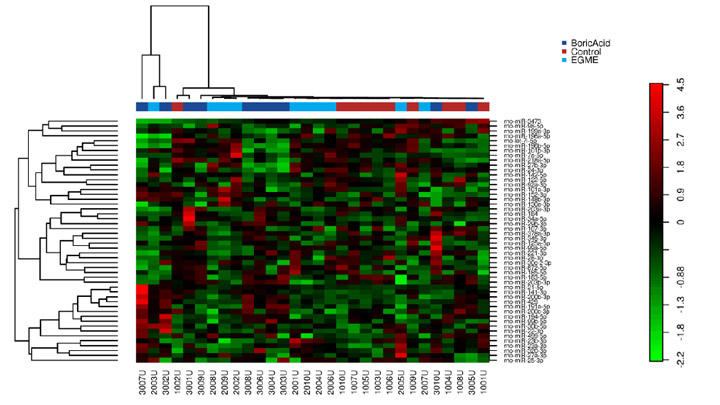Presentation #3 (Poster)

miRNA Profile Assessment of Urine Exosomes from Boric Acid Treated Rats as Potential Biomarkers for Testicular Toxicity
R. Wayne Ball1, Barbara Gould2, and Jason Wise2
1 REACH Borates Consortium, Brussels, Belgium
2 QIAGEN Inc., Germantown, MD
Abstract:
The objective of this study is to identify miRNAs in urine specific to boric acid (BA) related
reproductive effects in rats. Urine samples were evaluated to identify differentially expressed
testicular-specific miRNAs in BA treated rats using next-generation sequencing (NGS). Boric acid
was administered to male Sprague Dawley rats via oral gavage at a dose level of 500 mg BA/kg
bw/day for 28 days, a dose level known to produce fertility effects in male rats with minimal overt
signs of toxicity. At the end of 28-days urine was collected over 24 hours. Urine samples were
shipped to QIAGEN Genomic Services for exosomes isolation and miRNA analysis. Histopathology
was conducted on testes and epididymis confirming BA treatment related effects. Test
substancerelated findings included lower epididymis weights, smaller epididymides, and
microscopic findings of cellular debris and decreased spermatid cellularity in the epididymis and
tubular degeneration/atrophy and atypical residual bodies in the testis. Tubular degeneration/atrophy
in the test substance-treated group was characterized by decreased numbers of germ cells with
degeneration of spermatocytes and spermatids. Urine exosomes and miRNA were isolated with
QIAseq 52 Spike-ins through exoRNeasy. miRNA sequencing was performed using an Illumina
NextSeq500. The miRNA library preparation was completed using the QIAseq miRNA Library Kit.
Several miRNAs were identified in rat urine as possible biomarkers for BA related effects on male
reproductive system: miR-34c-5p, miR-449a-5p and miR-122-5p were decreased in BA treated rats
compared to untreated controls. These miRNAs have also been identified to be decreased in humans
with sertoli cell related spermatogenic failure. BA has been shown to affect Sertoli Cells in the testes
of rats. Additionally, let-7-5p (decreased), mir-141-3p (increased) and miR21-5p (increased) were
differentially expressed in BA treated rats. These miRNAs have been identified as potential
biomarkers for human male non-obstructive azoospermia. Also, miR-27b-3p levels decreased in BA
treated rats shown to be associated with asthenozoospermia in humans. These results provide the
basis for the potential application of miRNAs as biomarkers for BA related testicular toxicity and
highlight the value of urine exosome miRNA NGS as a discovery tool.
See attached poster #3
Researcher email for contact: barbara.gould@qiagen.com

